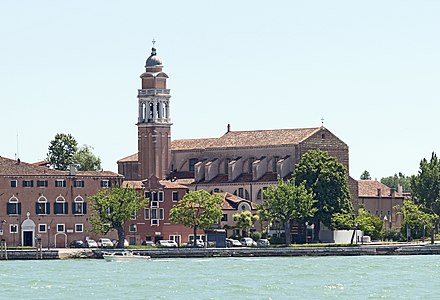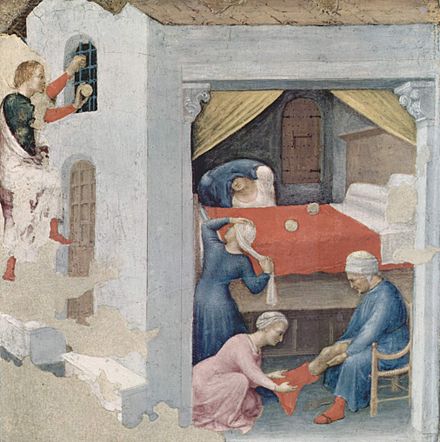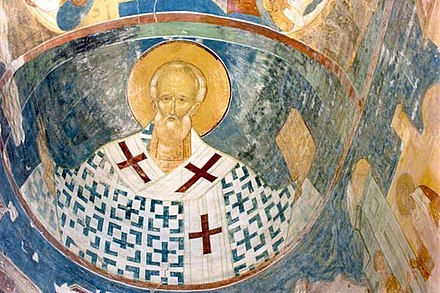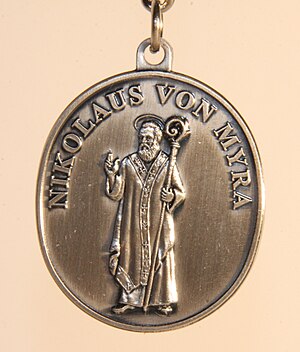Saint Nicholas
| Saint Nicholas | |
|---|---|
Russian icon depicting St Nicholas with scenes from his life. Late 15th century or early 16th century. National Museum, Stockholm. | |
| Defender of Orthodoxy, Wonderworker, Holy Hierarch, Bishop of Myra | |
| Born | 15 March 270[1] Patara, Roman Empire |
| Died | 6 December 343 (aged 73) Myra, Roman Empire |
| Venerated in | Anglicanism, Baptist, Catholicism, Eastern Orthodoxy, Oriental Orthodoxy, Lutheranism, Methodism, Presbyterianism, Reformed |
| Major shrine | Basilica di San Nicola, Bari, Italy |
| Feast | 6 December [O.S. 19 December] (main feast day – Saint Nicholas Day) 9 May [O.S. 22 May] (translation of relics)[2] |
| Attributes | Vested as a Bishop. In Eastern Christianity, wearing an omophorion and holding a Gospel Book. Sometimes shown with Jesus Christ over one shoulder, holding a Gospel Book, and with the Theotokos over the other shoulder, holding an omophorion |
| Patronage | Children, coopers, sailors, fishermen, merchants, broadcasters, the falsely accused, repentant thieves, brewers, pharmacists, archers, pawnbrokers, Aberdeen, Galway, Russia, Greece, Hellenic Navy, Liverpool, Bari, Siggiewi, Moscow, Amsterdam, Lorraine and Duchy of Lorraine. |
Saint Nicholas (Greek: Ἅγιος Νικόλαος, Hágios Nikólaos, Latin: Sanctus Nicolaus); (15 March 270 – 6 December 343),[3][4] also called Nikolaos of Myra, was a historic 4th-century Christian saint and Greek[5] Bishop of Myra, in Asia Minor (modern-day Demre, Turkey).[6] Because of the many miracles attributed to his intercession, he is also known as Nikolaos the Wonderworker (Νικόλαος ὁ Θαυματουργός, Nikólaos ho Thaumaturgós). His reputation evolved among the faithful, as was common for early Christian saints,[7] and his legendary habit of secret gift-giving gave rise to the traditional model of Santa Claus through Sinterklaas.
The historical Saint Nicholas is commemorated and revered among Anglican,[8] Catholic, Lutheran, and Orthodox Christians. In addition, some Baptist,[9] Methodist,[10] Presbyterian,[11] and Reformed churches have been named in honor of Saint Nicholas.[12] Saint Nicholas is the patron saint of sailors, merchants, archers, repentant thieves, children, brewers, pawnbrokers and students in various cities and countries around Europe.
The historical Saint Nicholas, as known from strict history: He was born at Patara, Lycia in Asia Minor (now Turkey). In his youth he made a pilgrimage to Egypt and the Palestine area. Shortly after his return he became Bishop of Myra and was later cast into prison during the persecution of Diocletian. He was released after the accession of Constantine and was present at the Council of Nicaea. In 1087, Italian merchants stole his body from Myra, bringing it to Bari in Italy.[13][14][15]
Contents
[hide]Life[edit]
Nicholas was born in Asia Minor (Greek Anatolia in present-day Turkey) in the Roman Empire, to a Greek family[16][17][18] during the third century in the city of Patara (Lycia et Pamphylia),[19][20] a port on the Mediterranean Sea.[20] He lived in Myra, Lycia[21] (part of modern-day Demre), at a time when the region was Greek in its heritage,[20] culture, and outlook and politically part of the Roman diocese of Asia.[20] He was the only son of wealthy Christian parents named Epiphanius (Ἐπιφάνιος, Epiphánios) and Johanna (Ἰωάννα, Iōánna) according to some accounts[22] and Theophanes (Θεοφάνης, Theophánēs) and Nonna (Νόννα, Nónna) according to others.[20] He was very religious from an early age[18] and according to legend, Nicholas was said to have rigorously observed the canonical fasts of Wednesdays and Fridays. His wealthy parents died in an epidemic while Nicholas was still young and he was raised by his uncle—also named Nicholas—who was the bishop of Patara. He tonsured the young Nicholas as a reader and later ordained him a presbyter (priest).
In the year AD 305, several monks from Anatolia in Asia Minor came to the Holy Land to Beit Jala, Judea and established a small monastery with a church named in honor of the Great Martyr George (Saint George). This was before St. Sava’s Monastery was founded in the desert east of Bethlehem on the Kidron Gorge near the Dead Sea. These monks lived on the mountain overlooking Bethlehem in a few caves. In the years 312-315, St. Nicholas lived there and came as a pilgrim to visit the Holy Sepulchre, Golgotha, Bethlehem, and many other sites in the Holy Land. The Saint Nicholas Greek Orthodox Church is located on the site of his cave in Beit Jala where today there are innumerable stories about Nicholas still handed down from generation to generation.[23] A text written in his own hand is still in the care of the Greek Orthodox Patriarch of Jerusalem. In 317 he returned to Asia Minor and was soon thereafter consecrated bishop in Myra.[24]
In 325, he was one of many bishops to answer the request of Constantine and appear at the First Council of Nicaea; the 151st attendee was listed as "Nicholas of Myra of Lycia".[25] There, Nicholas was a staunch anti-Arian, defender of the Orthodox Christian position,[26] and one of the bishops who signed the Nicene Creed.[27] Tradition has it that he became so angry with the heretic Arius during the Council that he struck him in the face.[28]
Demre[edit]
The modern city of Demre, Turkey is built near the ruins of the saint's home town of ancient Myra, and attracts many Russian tourists as St. Nicholas is a very popular Orthodox saint. Restoration of Saint Nicholas' original church is currently underway, with the Ministry of Culture and Tourism in 2007 permitting Divine Liturgy to be celebrated at the site, and contributing 40,000 Turkish Lira to the project.[29]
A solemn bronze statue of the saint by Russian sculptor Gregory Pototsky was donated by the Russian government in 2000, and was given a prominent place in the square fronting the medieval Church of St. Nicholas. In 2005, mayor Süleyman Topçu had the statue replaced by a red-suited plastic Santa Claus statue, because he wanted an image more recognisable to foreign visitors. Protests from the Russian government against this were successful, and the bronze statue was returned (albeit without its original high pedestal) to a corner nearer the church.[30]
Relics[edit]

On 26 August 1071 Romanus IV, Emperor of the Byzantine Empire (reigned 1068–1071), faced Sultan Alp Arslan of the Seljuk Turks (reigned 1059–1072) in the Battle of Manzikert. The battle ended in humiliating defeat and capture for Romanus. As a result, the Empire temporarily lost control over most of Asia Minor to the invading Seljuk Turks. The Byzantines would regain its control over Asia Minor during the reign of Alexius I Comnenus (reigned 1081–1118). But early in his reign Myra was overtaken by the Turks. Nicholas' tomb in Myra had become a popular place of pilgrimage. Because of the many wars and attacks in the region, some Christians were concerned that access to the tomb might become difficult. For both the religious and commercial advantages of a major pilgrimage site, the Italian cities of Venice and Bari vied to get the Nicholas relics.[3] Taking advantage of the confusion, in the spring of 1087, sailors from Bari in Apulia seized part of the remains of the saint from his burial church in Myra, over the objections of the Greek Orthodox monks. Returning to Bari, they brought the remains with them and cared for them. The remains arrived on 9 May 1087. There are numerous variations of this account. In some versions those taking the relics are characterized as thieves or pirates, in others they are said to have taken them in response to a vision wherein Saint Nicholas himself appeared and commanded that his relics be moved in order to preserve them from the impending Muslim conquest. Currently at Bari, there are two churches at his shrine, one Roman Catholic and one Orthodox.
Sailors from Bari collected just half of Nicholas' skeleton, leaving all the minor fragments in the grave. These were collected by Venetian sailors during the first crusade and brought to Venice, where a church to St. Nicholas, the patron of sailors, was built on the Lido. This tradition was confirmed in two scientific investigations of the relics in Bari and Venice, which revealed that the relics in the two cities belong to the same skeleton.[31][32] Many churches in Europe, Russia and the United States claim to possess small relics, such as a tooth or a finger.[33]
It is said that in Myra the relics of Saint Nicholas each year exuded a clear watery liquid which smells like rose water, called manna (or myrrh), which is believed by the faithful to possess miraculous powers.[34] After the relics were brought to Bari, they continued to do so, much to the joy of the new owners. Vials of myrrh from his relics have been taken all over the world for centuries, and can still be obtained from his church in Bari. Even up to the present day, a flask of manna is extracted from the tomb of Saint Nicholas every year on 6 December (the Saint's feast day) by the clergy of the basilica. The myrrh is collected from a sarcophagus which is located in the basilica vault and could be obtained in the shop nearby. The liquid gradually seeps out of the tomb, but it is unclear whether it originates from the body within the tomb, or from the marble itself; since the town of Bari is a harbour, and the tomb is below sea level, there have been several natural explanations proposed for the manna fluid, including the transfer of seawater to the tomb by capillary action.
In 1993, a grave was found on the small Turkish island of Gemile, east of Rhodes, which historians believe is the original tomb of Saint Nicholas.[35] on 28 December 2009, the Turkish Government announced that it would be formally requesting the return of St. Nicholas's skeletal remains to Turkey from the Italian government.[36][37] Turkish authorities have asserted that St. Nicholas himself desired to be buried at his episcopal town, and that his remains were illegally removed from his homeland.
An Irish tradition states that the relics of Saint Nicholas are also reputed to have been stolen from Myra by local Norman crusading knights in the 12th century and buried near Thomastown, Co. Kilkenny, where a stone slab marks the site locally believed to be his grave.[38] This is not widely accepted beyond local tradition.
Miracles and other stories[edit]
Numerous stories, some miraculous, are told about Nicholas.

One tells how during a terrible famine, a malicious butcher lured three little children into his house, where he killed them, placing their remains in a barrel to cure, planning to sell them off as ham.[39] Nicholas, visiting the region to care for the hungry, not only saw through the butcher's horrific crime but also resurrected the three boys from the barrel by his prayers. Another version of this story, possibly formed around the 11th century, claims that the butcher's victims were instead three clerks who wished to stay the night. The man murdered them, and was advised by his wife to dispose of them by turning them into meat pies. The saint saw through this and brought the men back to life.

According to another story, during a great famine that Myra experienced in 311–312, a ship was in the port at anchor, loaded with wheat for the Emperor in Constantinople. Nicholas invited the sailors to unload a part of the wheat to help in the time of need. The sailors at first disliked the request, because the wheat had to be weighed accurately and delivered to the Emperor. only when Nicholas promised them that they would not suffer any loss for their consideration, the sailors agreed. When they arrived later in the capital, they made a surprising find: the weight of the load had not changed, although the wheat removed in Myra was enough for two full years and could even be used for sowing.[40]
While yet a young man, Nicholas followed the example of his uncle, the abbot, by making a pilgrimage to the birthplace of Christianity—the Holy Land. Desiring a serene time of preparation, Nicholas set sail on an Egyptian ship where the other pilgrims did not know who he was. The first night he dreamed a storm would put them all at peril. When he awoke in the morning he warned the sailors that a severe storm was coming, but they need not fear, for "God will protect us." Almost immediately the sky darkened and strong winds roared round the ship. The wind and waves made it impossible to keep the ship under control. Even with lowered sails, the sailors feared for their very lives and begged Nicholas to pray for safety. one sailor climbed the main mast, tightening the ropes so the mast would not crash onto the deck. As he was coming back down, the sailor slipped, fell to the deck, and was killed. While Nicholas prayed, the storm did quiet, relieving the sailors. Their comfort, however, was dampened by grief over their comrade's death. As Nicholas prayed over the dead sailor, he was revived, "as if he had only been asleep." The man awakened without pain and the ship finished the journey to the Holy Land. Nicholas then embarked on his pilgrimage to the holy places, walking where Jesus had walked.
One night while staying with a family in Jerusalem, he wanted to pray at the only church remaining in Jerusalem at that time. It was the Church of the Room of the Last Supper on Mount Zion. As he approached the heavy, locked doors, they swung open of their own accord, allowing him to enter the church. Nicholas fell to the ground in thanksgiving.[41]

In his most famous exploit,[42] Nicholas aided a poor man who had three daughters, but could not afford a proper dowry for them. This meant that they would remain unmarried and probably, in absence of any other possible employment, would have to become prostitutes. Even if they did not, unmarried maidens in those days would have been assumed as being a prostitute. Hearing of the girls' plight, Nicholas decided to help them, but being too modest to help the family in public (or to save them the humiliation of accepting charity), he went to the house under the cover of night and threw three purses (one for each daughter) filled with gold coins through the window opening into the house.
One version has him throwing one purse for three consecutive nights. Another has him throwing the purses over a period of three years, each time the night before one of the daughters comes of age. Invariably, the third time the father lies in wait, trying to discover the identity of their benefactor. In one version the father confronts the saint, only to have Nicholas say it is not him he should thank, but God alone. In another version, Nicholas learns of the poor man's plan and drops the third bag down the chimney instead; a variant holds that the daughter had washed her stockings that evening and hung them over the embers to dry, and that the bag of gold fell into the stocking.[43]
The stories with the most likely historical basis are the stories of Nicholas helping three girls and stories of Nicholas coming to the aid of sailors. Others, especially that of the three murdered children, are much later additions to Nicholas lore, historian Dr. Adam English concludes[44] in a new biography of Nicholas for Baylor University Press based on a four-year study of current historical research into Nicholas of Myra.
Santa Claus[edit]
Nicholas had a reputation for secret gift-giving, such as putting coins in the shoes of those who left them out for him, a practice celebrated on his feast day, 6 December. For those who still observe the Julian calendar the celebration will currently take place thirteen days later than it happens in the Gregorian calendar and Revised Julian calendar.[45] Nicholas thus became the model for Santa Claus, whose modern name comes from the Dutch Sinterklaas, itself from a series of elisions and corruptions of the transliteration of "Saint Nikolaos".[46]
Saint Nicholas, Santa Claus, the customs today started from miracles associated with him. Now, children at Christmas time continue to honour ("believe in") him.[47]
Face of the historical saint[edit]
Whereas the devotional importance of relics and the economics associated with pilgrimages caused the remains of most saints to be divided up and spread over numerous churches in several countries, St. Nicholas is unusual in that most of his bones have been preserved in one spot: his grave crypt in Bari. Even with the allegedly continuing miracle of the manna, the archdiocese of Bari has allowed for one scientific survey of the bones. In the late 1950s, during a restoration of the chapel, it allowed a team of hand-picked scientists to photograph and measure the contents of the crypt grave.[48]
In the summer of 2005, the report of these measurements was sent to a forensic laboratory in England. The review of the data revealed that the historical St. Nicholas was barely five feet in height and had a broken nose. The facial reconstruction was produced by Dr. Caroline Wilkinson at the University of Manchester and was shown on a BBC2 TV program 'The Real Face of Santa' [49]
Formal veneration[edit]

Among the Greeks and Italians he is a favorite of sailors, fishermen, ships and sailing. As such he has become over time the patron saint of several cities maintaining harbours. In centuries of Greek folklore, Nicholas was seen as "The Lord of the Sea", often described by modern Greek scholars as a kind of Christianized version of Poseidon. In modern Greece, he is still easily among the most recognizable saints and 6 December finds many cities celebrating their patron saint. He is also the patron saint of all of Greece and particularly of the Hellenic Navy.[50]
In the Eastern Orthodox Church, Saint Nicholas' memory is celebrated on almost every Thursday of the year (together with the Apostles) with special hymns to him which are found in the liturgical book known as the Octoechos. Soon after the transfer of Saint Nicholas' relics from Myra to Bari, a Russian version of his Life and an account of the transfer of his relics were written by a contemporary to this event.[51] Devotional akathists and canons have been composed in his honour, and are frequently chanted by the faithful as they ask for his intercession. He is mentioned in the Liturgy of Preparation during the Divine Liturgy (Eastern Orthodox Eucharist) and during the All-Night Vigil. Many Orthodox churches will have his icon, even if they are not named after him.

In Oriental Orthodoxy, the Coptic Church observes the Departure of St. Nicholas on 10 Kiahk, or 10 Taḫśaś in Ethiopia, which corresponds to Julian 6 December.[52][53]
In late medieval England, on Saint Nicholas' Day parishes held Yuletide "boy bishop" celebrations. As part of this celebration, youths performed the functions of priests and bishops, and exercised rule over their elders. Today, Saint Nicholas is still celebrated as a great gift-giver in several Western European and Central European countries. According to one source, in medieval times nuns used the night of 6 December to deposit baskets of food and clothes anonymously at the doorsteps of the needy. According to another source, on 6 December every sailor or ex-sailor of the Low Countries (which at that time was virtually all of the male population) would descend to the harbour towns to participate in a church celebration for their patron saint. on the way back they would stop at one of the various Nicholas fairs to buy some hard-to-come-by goods, gifts for their loved ones and invariably some little presents for their children. While the real gifts would only be presented at Christmas, the little presents for the children were given right away, courtesy of Saint Nicholas. This and his miracle of him resurrecting the three butchered children made Saint Nicholas a patron saint of children and later students as well.[54]
Among Albanians, Saint Nicholas is known as Shen'Kollë and is venerated by most Catholic families, even those from villages that are devoted to other saints. The Feast of Saint Nicholas is celebrated on the evening before 6 December, known as Shen'Kolli i Dimnit (Saint Nicholas of Winter), as well as on the commemoration of the interring of his bones in Bari, the evening before 9 May, known as Shen'Kolli i Majit (Saint Nicholas of May). Albanian Catholics often swear by Saint Nicholas, saying "Pasha Shejnti Shen'Kollin!" ("May I see Holy Saint Nicholas!"), indicating the importance of this saint in Albanian culture, especially among the Albanians of Malësia. on the eve of his feast day, Albanians will light a candle and abstain from meat, preparing a feast of roasted lamb and pork, to be served to guests after midnight. Guests will greet each other, saying, "Nata e Shen'Kollit ju nihmoftë!" ("May the Night of Saint Nicholas help you!") and other such blessings. The bones of Albania's greatest hero, George Kastrioti, were also interred in the Church of Saint Nicholas in Lezha, Albania, upon his death.[55]
Iconography[edit]
Saint Nicholas is a popular subject portrayed on countless Eastern Orthodox icons, particularly Russian ones. He is depicted as an Orthodox bishop, wearing the omophorion and holding a Gospel Book. Sometimes he is depicted wearing the Eastern Orthodox mitre, sometimes he is bareheaded. Iconographically, Nicholas is depicted as an elderly man with a short, full, white, fluffy beard and balding head. In commemoration of the miracle attributed to him by tradition at the Council of Nicea, he is sometimes depicted with Christ over his left shoulder holding out a Gospel Book to him and the Theotokos over his right shoulder holding the omophorion. Because of his patronage of mariners, occasionally Saint Nicholas will be shown standing in a boat or rescuing a drowning sailor/s; Medieval Chants and Polyphony, image on the cover of the Book of Hours of Duke of Berry, 1410 [56]

In Roman Catholic iconography, Saint Nicholas is depicted as a bishop, wearing the insignia of this dignity: a bishop's vestments, a mitre and a crozier. The episode with the three dowries is commemorated by showing him holding in his hand either three purses, three coins or three balls of gold. Depending on whether he is depicted as patron saint of children or sailors, his images will be completed by a background showing ships, children or three figures climbing out of a wooden barrel (the three slaughtered children he resurrected).[57] In medieval paintings, Saint Nicholas is depicted as a dark-skinned man, as in Pietro di Giovanni d'Ambrogio's Saint Nicholas of Bari, a 1430s painting held at the Metropolitan Museum of Art, or Francesco di Giorgio e di Lorenzo's 1461 Altarpiece with the Annunciation made for the church of Spedaletta.[58]
In a strange twist, the three gold balls referring to the dowry affair are sometimes metaphorically interpreted as being oranges or other fruits. As in the Low Countries in medieval times oranges most frequently came from Spain, this led to the belief that the Saint lives in Spain and comes to visit every winter bringing them oranges, other 'wintry' fruits and tales of magical creatures.[57]
In music[edit]
- San Nicola di Bari, an oratorio composed by Giovanni Bononcini (1693).
- St. Nicolas, a choral song for male choir by Edward Purcell (1730).
- Saint Nicolas, a Christmas cantata by Benjamin Britten (1948).
- St. Nicholas arrives (Miklavž prihaja), a Christmas operetta in three acts by Salesian priest Jerko Gržinčič. The premiere took place before World War II in the Union Hostel in Ljubljana (now in Slovenia) with great success.[citation needed][59]
'겨울' 카테고리의 다른 글
| The Water Club, Manhattan 12/24/2016 (0) | 2016.12.24 |
|---|---|
| Winter solstice (0) | 2016.12.22 |
| 정월 대보름 (0) | 2016.02.03 |
| X-Mas Day 12/25/2015 (0) | 2015.12.25 |
| Riviera Ristorante 12/24/2015 (0) | 2015.12.24 |






